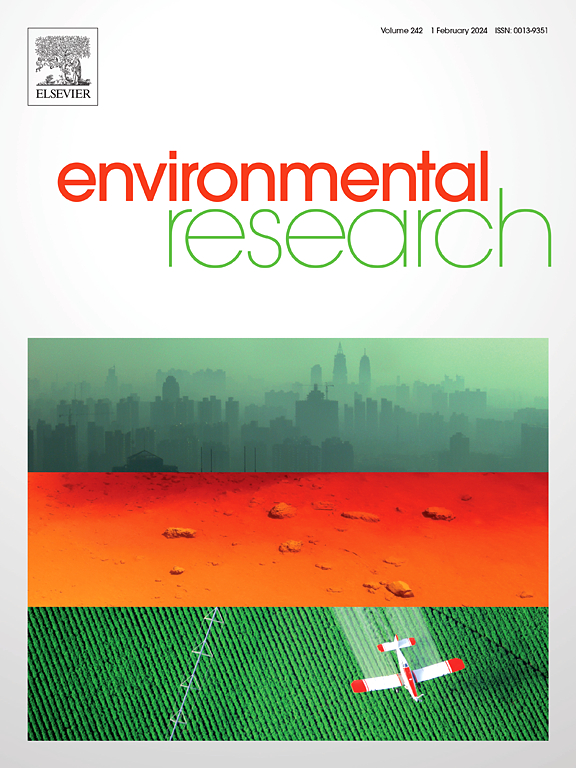芬兰城市污水处理厂进水、活性污泥和流出物中使用复合和抓取样本的病毒检测。
IF 7.7
2区 环境科学与生态学
Q1 ENVIRONMENTAL SCIENCES
引用次数: 0
摘要
基于废水的监测已被普遍用作公共卫生的监测工具。此外,废水中存在的病毒可能构成健康风险。本研究采用逆转录定量聚合酶链式反应和定量聚合酶链式反应对不同废水样品类型中的肠道病毒、鼻病毒、诺如病毒GI和GII、泛腺病毒和胃肠炎腺病毒F40/41进行了筛选。我们分析了从芬兰Pirkanmaa地区六个城市污水处理厂收集的复合进水样本(N = 22)、抓取进水样本(N = 20)、复合出水样本(N = 78)、抓取出水样本(N = 21)和活性污泥样本(N = 34)。我们检测了进水中的病毒,以发现是否有可能使用基于废水的监测来监测它们。此外,我们还研究了污水和活性污泥中的病毒,以检测在处理过程中持续存在的病毒。此外,对所有样品类型进行比较,发现不同废水样品类型的病毒含量存在差异。我们在进水中检测到所有研究病毒,在活性污泥中检测到肠道病毒、泛腺病毒和腺病毒F40/41,在出水中检测到肠道病毒、诺如病毒GI和GII、泛腺病毒和腺病毒F40/41。此外,所有病毒的相对量在进水中最高。我们的研究还表明,复合采样比抓取采样更具有代表性和灵敏度,因为复合样品中病毒的相对含量高于抓取样品。由于我们在污水中发现了大量的病毒,因此需要进一步研究它们作为环境污染物的传染性和潜在的健康风险。本文章由计算机程序翻译,如有差异,请以英文原文为准。
Virus detection in influent, activated sludge, and effluent from municipal wastewater treatment plants using composite and grab samples in Finland
Wastewater-based surveillance has been commonly used as a monitoring tool for public health. Also, viruses present in wastewater can pose a health risk. In this study, we screened enterovirus, rhinovirus, norovirus GI and GII, pan-adenovirus, and gastroenteritis-causing adenovirus F40/41 in different wastewater sample types using reverse transcription quantitative polymerase chain reaction and quantitative polymerase chain reaction. We analyzed composite influent samples (N = 22), grab influent samples (N = 20), composite effluent samples (N = 78), grab effluent samples (N = 21), and activated sludge samples (N = 34) collected from six municipal wastewater treatment plants in the Pirkanmaa region of Finland. We detected the viruses in the influent to discover if they had the potential to be monitored using wastewater-based surveillance. In addition, we studied viruses in effluent and activated sludge to detect viruses that persisted in treatment processes. Furthermore, all sample types were compared to discover differences in the viral contents of different wastewater sample types. We detected all the studied viruses in influent, while in activated sludge, we detected enterovirus, pan-adenovirus, and adenovirus F40/41, and in effluent enterovirus, norovirus GI and GII, pan-adenovirus, and adenovirus F40/41 were identified. In addition, the relative amount of all the viruses was the highest in the influent. Our study also showed that composite sampling was a more representative and sensitive method for virus monitoring in wastewater than grab sampling, as the relative amount of the viruses present in composite samples was higher than in grab samples. Since we found abundant viruses in effluent, further studies are required to assess their infectivity and potential health risks as environmental pollutants.
求助全文
通过发布文献求助,成功后即可免费获取论文全文。
去求助
来源期刊

Environmental Research
环境科学-公共卫生、环境卫生与职业卫生
CiteScore
12.60
自引率
8.40%
发文量
2480
审稿时长
4.7 months
期刊介绍:
The Environmental Research journal presents a broad range of interdisciplinary research, focused on addressing worldwide environmental concerns and featuring innovative findings. Our publication strives to explore relevant anthropogenic issues across various environmental sectors, showcasing practical applications in real-life settings.
 求助内容:
求助内容: 应助结果提醒方式:
应助结果提醒方式:


